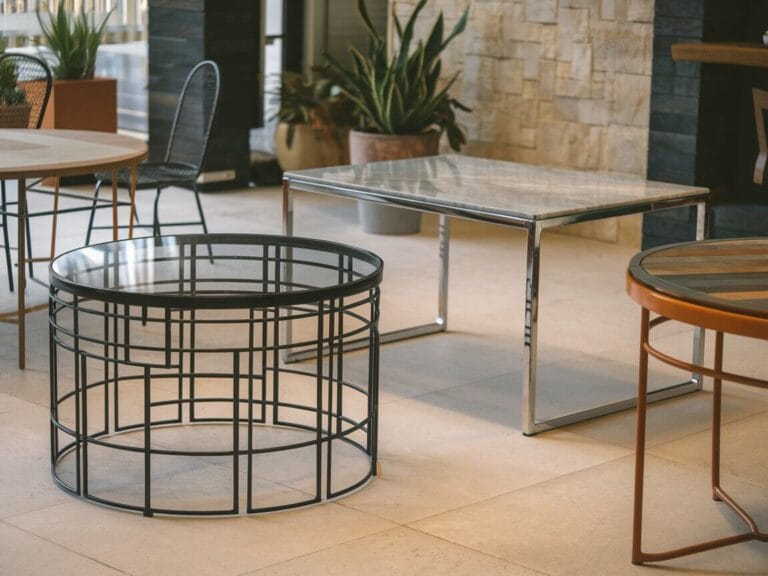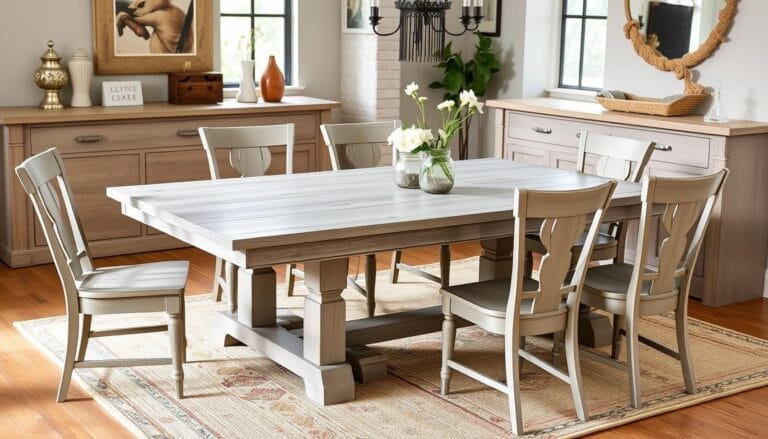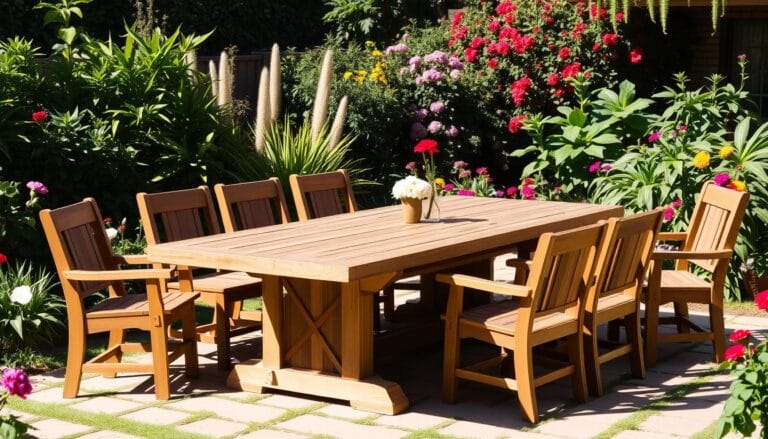When comparing metal dining tables for your home, you’ll quickly discover why these versatile pieces have become the go-to choice for modern homeowners. The process of comparing metal dining tables reveals significant differences in durability, style, and functionality that can dramatically impact your dining experience. Whether you’re drawn to industrial aesthetics or contemporary elegance, understanding these distinctions will help you make the perfect choice.
Metal dining tables have revolutionized modern interior design with their exceptional blend of form and function. Their growing popularity stems from an unmatched combination of durability, design flexibility, and practical benefits that traditional wooden tables simply cannot match.
Table of Contents
Why Metal Dining Tables Are Worth Comparing
The appeal of metal dining tables extends far beyond their striking visual impact. When comparing metal dining tables to other materials, several key advantages emerge that make them particularly attractive for today’s busy households.
Unmatched Durability and Longevity Metal dining tables consistently outperform their wooden and glass counterparts in terms of structural integrity. Unlike wood, which can warp, crack, or suffer water damage, metal maintains its shape and strength for decades. This durability makes them ideal for families with children, frequent entertainers, or anyone seeking a long-term furniture investment.
Design Versatility Across Interior Styles One of the most compelling aspects when comparing metal dining tables is their remarkable adaptability. A single metal table can transition seamlessly from casual family dinners to formal entertaining, while wooden tables often feel locked into specific style categories.
Minimal Maintenance Requirements The practical benefits become apparent in daily use. Metal surfaces resist stains, scratches, and heat damage that would permanently mark wooden tables. A simple wipe-down with a damp cloth restores their original luster, making them perfect for busy households.
- Table Size: L60″ x W35″ x H28″, suits for 6-8 people; 2.6″ diameter of umbrella hole in the center fits most umbrellas, …
- Heavy-duty construction with powder-coating finish, resists rust and corrosion.
- A sturdy metal table designed in elegance. Thick metal frame is made of heavy duty steel which ensures stability and dur…
Comparing Metal Dining Table Styles: Finding Your Perfect Match
Industrial Chic: Raw Sophistication
Industrial-style metal dining tables embrace an unapologetically bold aesthetic that celebrates raw materials and functional design. These tables typically feature thick steel frames with visible welds, distressed finishes, and substantial proportions that command attention.
Key characteristics include exposed metal construction, often combined with reclaimed wood tops, creating a striking contrast between warm and cool materials. The finish typically showcases the metal’s natural patina or deliberately distressed surfaces that tell a story of industrial heritage.
Best suited for urban lofts, converted warehouses, or any space where architectural elements like exposed brick, concrete floors, or metal ductwork create an authentic industrial atmosphere.
Contemporary Elegance: Sleek Minimalism
Contemporary metal dining tables prioritize clean lines, geometric precision, and understated sophistication. These designs often incorporate premium materials like tempered glass tops, marble surfaces, or high-gloss metal finishes that reflect light beautifully.
The construction focuses on seamless joints, polished surfaces, and proportions that feel perfectly balanced. Chrome, brushed stainless steel, and powder-coated finishes in neutral tones dominate this category.
Perfect for modern homes with open floor plans, minimalist decor, or spaces where the dining table serves as both functional furniture and sculptural art piece.
Rustic Charm: Warmth Meets Strength
Rustic metal dining tables masterfully combine the cozy appeal of traditional country style with the practical benefits of metal construction. These pieces typically feature wrought iron bases with intricate scrollwork, paired with natural wood tops that showcase beautiful grain patterns.
The metal components often display hand-forged details, antique finishes, or deliberately weathered patinas that suggest generations of use. This style celebrates craftsmanship and creates an inviting atmosphere for family gatherings.
Ideal for farmhouse kitchens, country homes, or any space where comfort and tradition take precedence over cutting-edge design trends.
Mid-Century Modern: Retro Sophistication
Mid-century modern metal dining tables capture the optimistic spirit of 1950s and 1960s design with their emphasis on functional beauty and innovative materials. These tables feature distinctive tapered legs, smooth surfaces, and proportions that feel both substantial and graceful.
The aesthetic emphasizes geometric shapes, often incorporating curves alongside straight lines. Finishes tend toward warm metals like brass or copper, or sleek options like brushed aluminum with subtle texture.
Perfect for homes that celebrate vintage design elements, collectors of mid-century furniture, or anyone seeking to add retro sophistication to their dining space.
Eclectic Fusion: Personal Expression
Eclectic metal dining tables break conventional design rules by combining multiple materials, colors, and styling elements into unique, personalized pieces. These tables might feature mixed metals, unconventional shapes, or artistic details that make them true conversation starters.
The beauty lies in their unpredictability – these tables reflect individual creativity and personal style rather than adherence to established design movements.
Ideal for creative individuals, art enthusiasts, or anyone who prefers furniture that tells a personal story rather than following trending aesthetics.
Comparing Metal Dining Table Materials: Performance and Aesthetics
- If you’re a trendsetter looking for your next great find, you’ve come to the right place. This vibrant metal café table …
- Smooth top with 1″ thick edge, Top Size: 31.5″W x 63″L
Stainless Steel: The Professional Choice
Stainless steel represents the gold standard when comparing metal dining tables for durability and hygiene. Its non-porous surface resists bacteria, stains, and corrosion, making it a favorite in both residential and commercial settings.
Advantages: Exceptional durability, completely rust-resistant, easy maintenance, modern aesthetic appeal, and compatibility with both indoor and outdoor use.
Considerations: Can show fingerprints and water spots, may feel cold to the touch, and typically commands higher prices than other metal options.
Best Applications: Contemporary kitchens, outdoor dining areas, homes with young children, or anyone prioritizing low-maintenance furniture.
Wrought Iron: Timeless Craftsmanship
Wrought iron brings centuries of metalworking tradition to modern dining spaces. This material allows for intricate decorative details, curved elements, and artistic flourishes that other metals cannot achieve.
Advantages: Extremely strong and stable, allows for decorative detailing, develops beautiful patina over time, and offers excellent value for handcrafted quality.
Considerations: Requires regular maintenance to prevent rust, heavier than other options, and limited to traditional or rustic styling.
Best Applications: Traditional homes, outdoor patios, rustic or farmhouse interiors, or spaces where decorative metalwork enhances the overall design.
Aluminum: Lightweight Versatility
Aluminum strikes an excellent balance between performance and practicality. Its natural rust resistance and lightweight properties make it increasingly popular for both indoor and outdoor dining furniture.
Advantages: Naturally rust-resistant, significantly lighter than steel or iron, excellent for outdoor use, and available in numerous finishes and colors.
Considerations: Less substantial feeling than heavier metals, can dent more easily than steel, and may not suit formal dining environments.
Best Applications: Casual dining areas, outdoor entertaining spaces, apartments where furniture may need frequent moving, or budget-conscious buyers seeking quality.
Brass: Luxury and Warmth
Brass brings warmth and luxury to metal dining tables with its rich golden tones and ability to develop a beautiful patina over time. This material works particularly well in vintage or eclectic design schemes.
Advantages: Beautiful warm color, develops character over time, excellent for vintage or luxury aesthetics, and naturally antimicrobial properties.
Considerations: Requires regular polishing to maintain shine, more expensive than basic metals, and can tarnish without proper care.
Best Applications: Formal dining rooms, vintage or antique-inspired interiors, luxury homes, or spaces where the dining table serves as a decorative focal point.
Practical Considerations When Comparing Metal Dining Tables
Size and Space Planning
Proper sizing remains crucial regardless of material choice. Measure your dining space carefully, allowing at least 36 inches of clearance around the table for comfortable seating and movement. Consider the table’s visual weight – darker metals appear heavier and can overwhelm smaller spaces, while lighter finishes help maintain an open feeling.
Functionality and Lifestyle Matching
Your lifestyle should heavily influence your choice when comparing metal dining tables. Active families might prefer durable stainless steel, while entertainers might gravitate toward elegant brass or sophisticated contemporary designs. Consider whether you need additional features like extension capabilities, storage options, or specialized maintenance requirements.
Budget and Long-term Value
While metal dining tables often require higher initial investment than basic wooden alternatives, their longevity and minimal maintenance requirements typically provide excellent long-term value. Factor in potential refinishing costs, replacement timelines, and the table’s ability to adapt to changing decor preferences.
Maintenance and Care: Keeping Your Metal Table Perfect
Daily Care Routines
Most metal dining tables require only simple daily maintenance. Wipe surfaces with a soft, damp cloth after meals, and dry immediately to prevent water spotting. Use coasters and placemats to protect surfaces from scratches and heat damage.
Deep Cleaning Methods
Weekly deep cleaning varies by metal type. Stainless steel benefits from specialized cleaners that restore shine, while wrought iron may need occasional rust prevention treatments. Brass requires periodic polishing to maintain its lustrous appearance.
Long-term Preservation
Proper long-term care ensures your metal dining table maintains its beauty for decades. Apply protective finishes as recommended by manufacturers, address any damage promptly, and consider professional restoration for valuable pieces showing wear.
Making Your Final Decision
When comparing metal dining tables, prioritize factors that align with your specific needs, lifestyle, and aesthetic preferences. Consider how the table will function in your space, complement your existing decor, and serve your family’s needs for years to come.
The perfect metal dining table balances visual appeal with practical performance, creating a piece that enhances both daily family meals and special occasions. By understanding the unique characteristics of different styles and materials, you can confidently choose a table that will become a cherished centerpiece of your home.
Frequently Asked Questions
Are metal dining tables suitable for outdoor use? Many metal dining tables excel outdoors, particularly those made from aluminum, stainless steel, or properly treated wrought iron. Always verify outdoor ratings with manufacturers and consider protective covers during harsh weather.
How do I maintain the finish of my metal dining table? Maintenance varies by material. Use soft cloths and appropriate cleaners for your specific metal type. Avoid abrasive materials that can scratch surfaces, and apply protective treatments as recommended.
Can metal dining tables fit into small dining areas? Absolutely! Round or oval metal tables maximize seating in compact spaces, while their sleek profiles can make rooms appear larger than wooden alternatives.
How do I choose the right style for my metal dining table? Consider your home’s overall aesthetic, lifestyle needs, and personal preferences. Industrial styles suit modern urban spaces, while rustic options complement traditional homes beautifully.
Are metal dining tables environmentally friendly? Metal tables can be highly sustainable, especially when made from recycled materials. Many metals are infinitely recyclable, making them excellent long-term environmental choices.
Do metal tables get too cold or hot? Surface temperature varies by metal type and environmental conditions. Most metals reach room temperature quickly, and table linens can provide comfort if needed during extreme temperatures.
Metal dining tables offer an unparalleled combination of durability, style, and functionality that makes them worthy investments for any home. By carefully comparing metal dining tables across styles, materials, and features, you’ll find the perfect piece to enhance your dining experience and complement your unique style for years to come.






